I try to filter a signal using opencv's dft function. The way I try to this is taking the signal in time domain:
x = [0.0201920000000000 -0.0514940000000000 0.0222140000000000 0.0142460000000000 -0.00313500000000000 0.00270600000000000 0.0111770000000000 0.0233470000000000 -0.00162700000000000 -0.0306280000000000 0.0239410000000000 -0.0225840000000000 0.0281410000000000 0.0265510000000000 -0.0272180000000000 0.0223850000000000 -0.0366850000000000 0.000515000000000000 0.0213440000000000 -0.0107180000000000 -0.0222150000000000 -0.0888300000000000 -0.178814000000000 -0.0279280000000000 -0.144982000000000 -0.199606000000000 -0.225617000000000 -0.188347000000000 0.00196200000000000 0.0830530000000000 0.0716730000000000 0.0723950000000000]
Convert it to FOURIER domain using :
cv::dft(x, x_fft, cv::DFT_COMPLEX_OUTPUT, 0);
Eliminate the unwanted frequencies:
for(int k=0; k<32;k++){
if(k==0 || k>6 )
{
x_fft.ptr<float>(0)[2*k+0]=0;
x_fft.ptr<float>(0)[2*k+1]=0;
}
}
Convert it back to time domain:
cv::dft(x_fft, x_filt, cv::DFT_INVERSE, 0);
In order to check my results I've compared them to Matlab. I took the same signal x, convert it to FOURIER using x_mfft = fft(x); The results are similar to the ones I get from opencv, excepting the fact that in opencv I only get the left side, while in matlab I get the symmetric values too.
After this I set to 0 in Matlab the values of x_mfft(0) and x_mfft(8:32) and now the signal look exactly the same except the fact that in Matlab they are in complex form, while in opencv they are separated, real part in one channel, imaginary part in the other.
The problem is that when I perform the inverse transform in matlab using x_mfilt = ifft(x_mfft) the results are completely different from what I get using opencv.
Matlab:
0.0126024108604191 + 0.0100628178150509i 0.00278762121814893 - 0.00615997579216921i 0.0116716145588075 - 0.0150834711251450i 0.0204808089882897 - 0.00937680194210788i 0.0187164132302469 - 0.000843687942567208i 0.0132322795522116 - 0.000108642129381095i 0.0140282455278201 - 0.00325620843335947i 0.0190436542174946 - 0.000556561558544529i 0.0182379867325824 + 0.00764390022568001i 0.00964801276734883 + 0.0107158342431018i 0.00405220362962359 + 0.00339496875258604i 0.0108096973356501 - 0.00476499376334313i 0.0236507440224628 - 0.000415067678294738i 0.0266197220512826 + 0.0154626911663024i 0.0142805873081583 + 0.0267004219364679i 0.000314527358302778 + 0.0215255889620223i 0.00173512964620177 + 0.00865151513638104i 0.0169666351363477 + 0.00836162056544561i 0.0255915540012784 + 0.0277878383595920i 0.0118710562486680 + 0.0506446948330055i -0.0160165379892836 + 0.0553846122152651i -0.0354343989166415 + 0.0406080858067314i -0.0370261047451452 + 0.0261077990289579i -0.0365120038155127 + 0.0268311542287801i -0.0541841640123775 + 0.0312446266697320i -0.0854132555297956 + 0.0125342802025550i -0.0989182320365535 - 0.0377079727602073i -0.0686133217915410 - 0.0925138855355046i -0.00474198249025186 - 0.111728716441247i 0.0515933837210975 - 0.0814138940625859i 0.0663201317560107 - 0.0279433757588921i 0.0426055814586485 + 0.00821080477569232i
OpenCV after cv::dft(x_fft, x_filt, cv::DFT_INVERSE, 0);
Channel 1:
0.322008 -0.197121 -0.482671 -0.300055 -0.026996 -0.003475 -0.104199 -0.017810 0.244606 0.342909 0.108642 -0.152477 -0.013281 0.494806 0.854412 0.688818 0.276848 0.267571 0.889207 1.620622 1.772298 1.299452 0.835450 0.858602 0.999833 0.401098 -1.206658 -2.960446 -3.575316 -2.605239 -0.894184 0.262747
Channel 2:
0.403275 0.089205 0.373494 0.655387 0.598925 0.423432 0.448903 0.609397 0.583616 0.308737 0.129670 0.345907 0.756820 0.851827 0.456976 0.010063 0.055522 0.542928 0.818924 0.379870 -0.512527 -1.133893 -1.184826 -1.168379 -1.733893 -2.733226 -3.165383 -2.195622 -0.151738 1.650990 2.122242 1.363375
What am I missing? Shouldn't the results be similar? How can I check if the inverse transform in opencv is done correctly?
Later EDIT: After struggling with the problems for a few hours now I've decided to plot the results from Matlab and OpenCV and to my surprise they were very much similar.
Imaginary parts

Real parts:

So obviously it's something about a SCALE factor. After dividing them element by element apparently this factor is 32 - the length of the signal. Can someone explain why this happens?
The obvious solution is to use cv::dft(x_fft, x_filt, cv::DFT_INVERSE+cv::DFT_SCALE, 0); so I guess this topic is answered but I'm still interested in why is it this way.